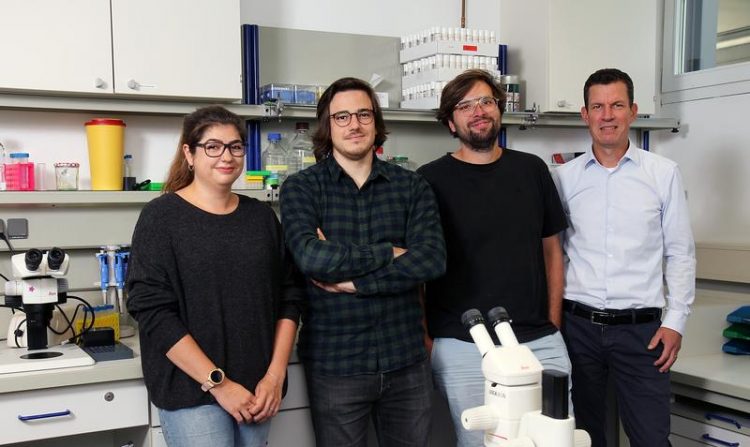Seeing memories being made

The researchers (left to right): Vanessa Bräuler, Benjamin Escribano, Dominique Siegenthaler and Prof. Dr. Jan Pielage Credit: Koziel/TUK
Researchers at Technische Universität Kaiserslautern have developed a novel tool for tracking and manipulating long-term memories as they are stored in the brains of fruit flies.
The tool, reported recently in the journal PLOS Biology, will help investigate how memory works at the molecular level. Insights gained from the simpler fruit fly brain can later guide studies of human memory.
Sorting out the specific mechanisms that lead to long-term memory formation in the fly brain is a challenge. The subset of neurons thought to be responsible for long-term memory have the same DNA as other neurons, making it difficult to design a biomarker that only identifies the neurons encoding a specific memory.
To overcome this problem, Dominique Siegenthaler, Benjamin Escribano and Vanessa Bräuler in the group of Professor Jan Pielage of TUK’s Division of Neurobiology and Zoology developed a genetic tag that responds to memory formation.
The tag is called CRE-activity dependent memory engram label, or CAMEL, for short. It utilizes the DNA-binding site of the CRE binding protein (CREB2), which is essential for the formation of long-term memories. The tag lights up when neurons have an active CREB protein binding to DNA, highlighting only the neurons in the process of forming a memory.
“For the first time, we can specifically control the neurons forming long-term memories in Drosophila,” Pielage said.
As if seeing memory formation in action was not exciting enough, the tag does much more. The researchers can also use it to inhibit or activate the neurons’ activities.
“Now we have genetic access to get after the cellular and molecular changes occurring during long term memory formation,” Pielage said.
For example, the team used their tag to inhibit signaling from the long-term memory neurons in fruit flies. They trained the flies to associate an odor with an electric shock. The flies were still able to learn and recall memory in the first three hours after training, indicating that short-term memory formation was not affected by silencing these neurons.
However, the flies were unable to recall the memory for the next four days, the time period when the CREB protein makes and maintains long-term memory. Interestingly, seven days after training, when CREB and thus the tag was no longer active, the flies again avoided the odor. This demonstrated that silencing CAMEL neurons specifically disrupted long-term memory recall but not production or storage of the memory.
To see if memories could be turned on artificially, the group tried a different experiment. They trained flies to associate an odor with a shock and then used their tag to express a channel that activates neurons when exposed to red light. When giving the flies the choice to move either in areas with or without red light, more flies chose to move to dark areas. This indicated that red light activated the neurons containing the “bad” memory about the odor and electric shock.
“The flies essentially avoided recalling this bad memory,” Pielage said.
Taken together, these experiments indicate that this small subset of tagged neurons is sufficient and required to make long-term memories, Pielage explained. The team next plans to create artificial memories in the flies, in order to systematically investigate the cellular changes that happen when creating and recalling memories.
“We still don’t know what happens in the neurons to store long-term memories or how we can recall memories,” Pielage said.
The study „Selective suppression and recall of long-term memories in Drosophila“ is published in PLOS Biology.
DOI: doi.org/10.1371/journal.pbio.3000400
Prof. Dr. Jan Pielage
Abteilung Zoologie-Neurobiologie
Tel: 0631 205-2426
E-Mail: pielage(at)bio.uni-kl.de
The study „Selective suppression and recall of long-term memories in Drosophila“ is published in PLOS Biology.
DOI: doi.org/10.1371/journal.pbio.3000400
Media Contact
More Information:
http://www.uni-kl.deAll latest news from the category: Life Sciences and Chemistry
Articles and reports from the Life Sciences and chemistry area deal with applied and basic research into modern biology, chemistry and human medicine.
Valuable information can be found on a range of life sciences fields including bacteriology, biochemistry, bionics, bioinformatics, biophysics, biotechnology, genetics, geobotany, human biology, marine biology, microbiology, molecular biology, cellular biology, zoology, bioinorganic chemistry, microchemistry and environmental chemistry.
Newest articles

Properties of new materials for microchips
… can now be measured well. Reseachers of Delft University of Technology demonstrated measuring performance properties of ultrathin silicon membranes. Making ever smaller and more powerful chips requires new ultrathin…

Floating solar’s potential
… to support sustainable development by addressing climate, water, and energy goals holistically. A new study published this week in Nature Energy raises the potential for floating solar photovoltaics (FPV)…

Skyrmions move at record speeds
… a step towards the computing of the future. An international research team led by scientists from the CNRS1 has discovered that the magnetic nanobubbles2 known as skyrmions can be…





















